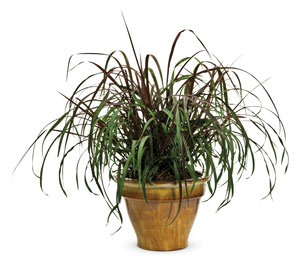11/24/2010
Graceful Grasses Vertigo: Pennisetum on Steroids
Rick Schoellhorn

When it comes to pennisetum grasses, it can be a bit confusing which ones will work in your operation. There are more than 500 species of this grass and they vary from hardy perennial forms to warm-season annuals. Graceful Grasses Vertigo is a form of
Pennisetum purpureum, which means two things: Vertigo is purple and it’s BIG! Remember that second part, as it’s a key point in growing this crop. The most similar cultivars you’ll see on the market are Prince, Princess and Princess Molly. Vertigo is finer textured than either Prince or Princess and much larger than Princess Molly. However, if you have grown these other cultivars before you’ll have a good idea of how to succeed with Vertigo.
Warmer is better. As with most pennisetums, warmer production conditions give the fastest growth and crop turnover. Foliage color darkens with increasing temperatures, as well. Night temperatures below 40F (4.4C) essentially stop growth of Vertigo and in other red pennisetum. It’s best to have day temperatures above 70F (21.1C) and night temperatures above 65F (18.3C). Don’t bring these grasses into your operation if you’re growing cool; they’ll stall and take longer on the bench. Also, chilling early in the crop cycle reduces overall branching and vigor, so please place your orders accordingly.
Bright light equals better color and form. Vertigo is a tropical grass; therefore, it needs warmth and high light levels. The high light levels deepen the purple foliage color and help keep the plants more compact while also adding to the number of side branches. Since they’re warm season grasses, they’ll grow more vigorously under longday photoperiods as well.
Plan for a BIG plant. The whole beauty of this plant is its size in containers and the landscape. It gets BIG! Imagine Red Fountain Grass about four times larger, and you’re close to the size of Vertigo. For this reason, it shouldn’t be grown in anything smaller than a gallon container. Even then, it might be good to look at using 2-gal. or 14-inch upright containers, as Vertigo will fill these containers quite quickly. From a liner, Vertigo establishes in the pot first by spreading out, and then the secondary shoots and leaves grow upward. At first it may look almost like it was a prostrate plant, but don’t be fooled. Once the new growth has been laid down, all the stems begin to grow upright and the next phase of growth is much more upright and mounding. Eventual height in the landscape is somewhere between 4 to 6 ft. tall depending on where in the country you’re growing. Plan ahead for the space needed.
Mixed containers and companion plantings. Vertigo is a high-vigor plant, so be sure to match it with plants that are also high vigor. It makes a great combination with Sweet Caroline ipomoea, Snow Princess lobularia and more vigorous petunia cultivars.
Grower basics
Fertilization using a standard balanced fertilizer is fine between 150-200 ppm. Once the weather warms, fertilizing more frequently will speed the crop. If conditions are cold, alternate with clear water to avoid high EC levels. Plant growth regulators are not really necessary, and the best plan is to grow the plants warm and fast to increase crop turns. When it comes to watering, you’ll need to keep an eye on the weather. During cool periods, water use is less, and when it heats up, you’ll need to check watering more frequently.
A side note on pennisetum in general: Always check with your local authorities for regional invasivity information as Texas, Florida and California have different environmental restrictions on certain tropical grasses. Graceful Grasses Vertigo is considered to be sterile.
GT
Dr. Rick Schoellhorn is the director of new products for Proven Winners LLC. He can be reached at rick@provenwinners.com.